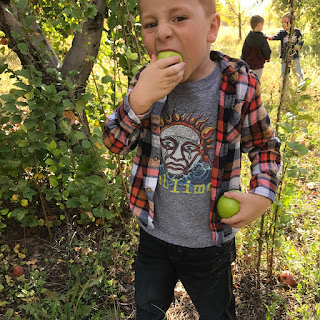My Apple Trees are Trying, Very Trying
Southwest Yard & Garden
by Dr. Marisa Thompson
 |
| Kindergartener enjoys an apple during a field trip to the Los Lunas Agricultural Science Center (M. Thompson). |
Question:
What am I doing wrong with my apple trees? I have two apple trees in my back yard that I planted a few years ago. They flowered each spring, but only produced a couple fruit per tree.
- Sandra L., Las Cruces, NM
Answer:
Fruit production can be very tricky in New Mexico, so you are not alone in feeling like you’re doing something wrong. In fact, there is an NMSU Extension publication entitled “Why Fruit Trees Fail to Bear” (http://aces.nmsu.edu/pubs/_h/H308/welcome.html). Let’s click through the ways to encourage better apple yields from your trees, starting with flower pollination.
For most apple cultivars (varieties), flowers need to be cross-pollinated with pollen from another apple cultivar in order to have good-quality fruit and good quantity, too. Even pollen from ornamental crabapple blossoms can be a pollinizer for apple flowers. Are your apple trees two different cultivars? If you know the cultivars, you can look them up to see if they are a good match for each other as far as the expected flowering times. If you suspect your two trees are the same cultivar and you have the extra space, one way to encourage successful pollination might be to plant a cultivar that is known to be a powerful pollinator, like ‘Jonathan’. For more information on cultivars that perform well in New Mexico, check out the NMSU Extension publications “Fruit Trees for the Home Orchard” (http://aces.nmsu.edu/pubs/_circulars/CR523.pdf) and “Fruits and Nuts for New Mexico Orchards” (http://aces.nmsu.edu/pubs/_h/H310/).
 |
| Crabapple blossoms (K. White). |
Even after successful flowering and pollination, fruit may not mature because of tissue damage if you get a late freeze. Planting late-blooming cultivars reduces the late frost threat, but even these will benefit from being covered with a blanket if temperatures are expected to drop below freezing in your area.
Other considerations: Do your trees have adequate space for healthy root growth? Trees planted in lawns require special attention because grass roots compete with young tree roots for water and nutrients. Additionally, lawns are usually irrigated frequently, but too shallowly for tree roots. If planted in late winter or early spring, water your fruit tree often enough to barely keep the soil moist in the root area. Once the tree starts to green up, irrigate approximately every 7 to 14 days, depending on soil type, during the first growing season. Watering intervals will be longer through the first winter and second growing season, but it is important to always irrigate deeply when irrigating trees. The majority of the roots doing all the absorptive work are in the top 3 feet of soil.
Mulch! Mulch! Mulch! Mulching with natural materials like wood chips or leaves is extremely important. Mulch helps soil hold moisture, encourages earthworms and beneficial fungi, and maintains steadier temperatures so tree roots do not get as cold in the winter or as hot in the summer. Plus, as natural mulches break down they slowly add nutrients back into the soil.
Apple trees respond well to proper annual pruning, may require fertilizer, and are susceptible to certain pests and diseases. For more information on all of these factors, visit http://aces.nmsu.edu/pubs/_h/#fruit.
For centuries, many New Mexicans have grown apple trees successfully, so do not give up!
Send gardening questions to Southwest Yard and Garden - Attn: Dr. Marisa Thompson at desertblooms@nmsu.edu, or at the Desert Blooms Facebook page (@NMDesertBlooms)
Please copy your County Extension Agent and indicate your county of residence when you submit your question!
For more gardening information, visit the NMSU Extension Horticulture page at Desert Blooms and the NMSU Horticulture Publications page at http://aces.nmsu.edu/pubs/_h/
Marisa Y. Thompson, PhD, is the Extension Horticulture Specialist, in the Department of Extension Plant Sciences at the New Mexico State University Los Lunas Agricultural Science Center, office: 505- 865-7340, ext. 113.



Comments
Post a Comment